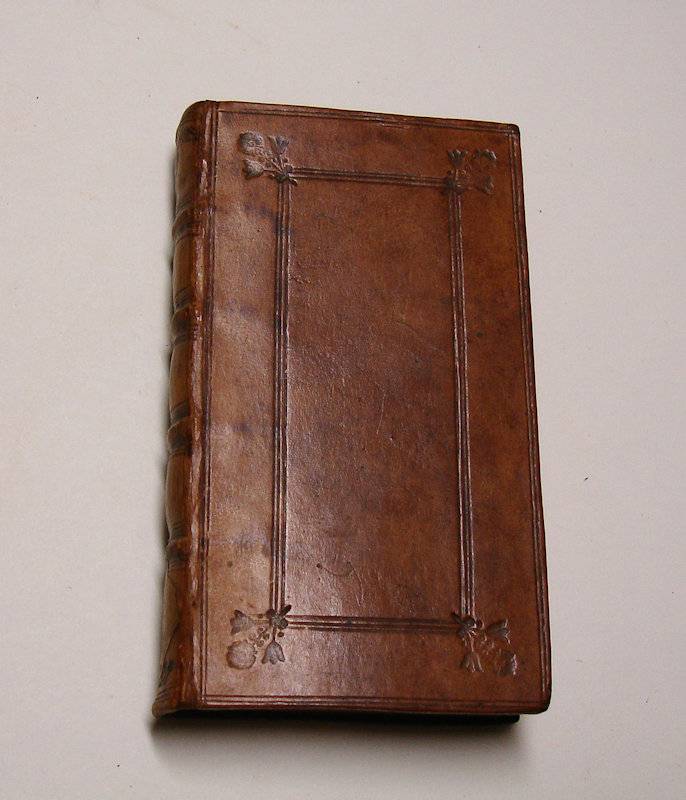TERENTIUS.
Pub. Terentii Comoediae sex. Ex recensione Heinsiana.
Leiden (Lugd. Batavorum), Ex officina Elzeviriana, 1635.
12mo. (XLVIII),304,(8 index) p., engraved title. Calf. 12 cm
An excellent edition, an attractive binding, tasteful typography (
Ref: Willems 433; Rahir 425; Berghman 2151; Schweiger 2,1065; Dibdin 2,472/73; Moss 2,671/72: 'one of the most beautiful'; Brunet 5,715/16; Graesse 6/1,59; Ebert 22507) (
Details: Nice binding. Back ruled blind, and with 4 raised bands. Boards with blind double and triple fillet borders, and fleurettes. All three edges of the boards gilt. Edges of the bookblock dyed red. Title engraved by Cornelis Cl. Du(y)send, it depicts the Roman general Scipio Africanus in armour, while putting the
pilleus, a felt hat, which was given to a slave at his enfranchisement as a sign of freedom, on the head of a half naked woman called 'Venus Afra', at her feet sits Amor. Since Terentius mentions Venus only once and incidentally, and Scipio didnot manumit the Carthagian Terentius, this scene must refer to the liberation of the African Muse, in the figure of Venus, and hence the freeing of the Muse of the African Terentius, by the conqueror of Hannibal and Carthage, Scipio Africanus. Woodcut portrait of Terence on p. *8 verso. The Elsevier brothers printed, according to Willems, 5 issues of this edition in 1635. This is the first and best one. 'La plus belle et la plus estimée est incontestablement la première, qui est un chef-d'oeuvre typographique'. The two Elsevier brothers, with the same refugee background as Heinsius, gradually brought their typographical artistry to a peak, and their production of this Terence edition of 1635 was the first of a series of technical masterpieces. (P.R. Selin, 'Daniel Heinsius and Stuart England', Leiden/London 1968, p. 10) (
Condition: Some slight wear to the extremes. An old paper label on lowest compartment of the back. Backstrip slightly beginning to give way at the joint between the head of the spine and the lower board) (
Note: The late antique grammarian Aelius Donatus (4th century A.D) wrote not only a commentary on the plays of the Roman playwright Publius Terentius Afer, ca. 190-159 B.C., but also a short biography, in which he tells that Terentius was born in the Roman province Africa and that he came as a slave in the houshold of the senator Terentius Lucanus. He adopted his name when he was manumitted. Terentius is the author of 'fabulae palliatae', which means 'plays in Greek cloths'. He adapted Greek plays, especially those of the Greek playwright Menander, to the taste of the Romans. Six of his comedies have survived. For later generations he became a model for elegant Latin. His style was closer to everyday conversation than Plautus', an earlier contemporary comic playwright, whose style was more extravagant. He was quoted by Cicero, Horace, Persius and the Church Fathers.
§ Ever since antiquity Terentius lived also a long and influential life in schools as a model for Latin language and rhetoric. In the Middle Ages he was read for his moral sentences. He was imitated by the German abbess Hrotsvitha of Gandersheim (ca. 935 - ca. 973) in her 'Dramenbuch', with which she wanted to create a Christian alternative for the pagan comedies. With the coming of humanism Terentius enjoyed a renaissance in the classroom and on stage. Scholars rejected the 'barbaries' of Medieval Latin and chose the elegance of Cicero and Terentius as their model. In his 'De ratione studii' (1511) the Dutch humanist Desiderius Erasmus, 1466-1536, encouraged the study of Terentius for his language and moral utility. 'Among Latin writers, who is more valuable as a standard of language than Terence? He is pure, concise, and closer to everyday speech and, by the very nature of his subject matter, is also congenial to youth'. (The Classical Tradition, 2010, p. 930) Erasmus published later in life, in 1532, an edition of Terentius' plays. Erasmus seems to have learned the whole of Terentius by heart in his youth. He admired the author for his 'latinitas' and his civilized humor. His ideal as a humanist and pedagogue was the creation of better men with the help of the classics. He held the opinion that schoolboys should read Terentius over and over again. Thus they could master a pure Latin style, and learn at the same time good morals.
§ The Dutch classical scholar of Flemish origin Daniel Heinsius, 1580-1655, who enjoyed international fame as an editor of more than 20 classical texts, theorist of literary criticism, historian and neolatin poet, was professor of Poetics at the University of Leiden since 1603, extraordinarius Greek since 1605. After the death of J. Scaliger, to whose inner circle he belonged, he held the chair of Greek, from 1609 till 1647. His Terentius edition, first published Amsterdam 1618, saw 15 reissues during his lifetime. Terentius, whose comedies were considered useful for a moral education, was, according to Heinsius, the best classical dramatist in conveying appropriately comic characters. 'Longe autem omnibus palmam hac in parte Terentius praeripuit. (...) Qui prae reliiquis scriptoribus decorum intellexit'. (D. Heinsius, 'De Tragoediae constitutione', 1611, p. 163) The text of Terence is preceded by Heinsius' famous treatise 'Ad Horatii de Plauto & Terentio judicium, dissertatio', first published in 1618) (
Collation: *8, 2*12, 3*4; A-N12) (Photographs on request)
Book number: 120319 Euro 300.00
Keywords: (Oude Druk), (Rare Books), Heinsius, Komödie, Latin literature, Terence, Terentius, antike altertum antiquity, comedy, römische Literatur
 TERENTIUS.
TERENTIUS.